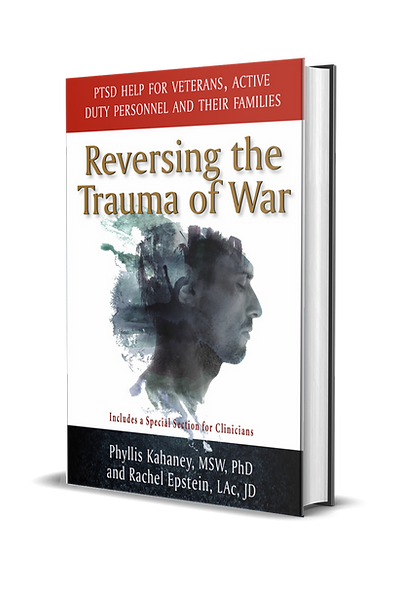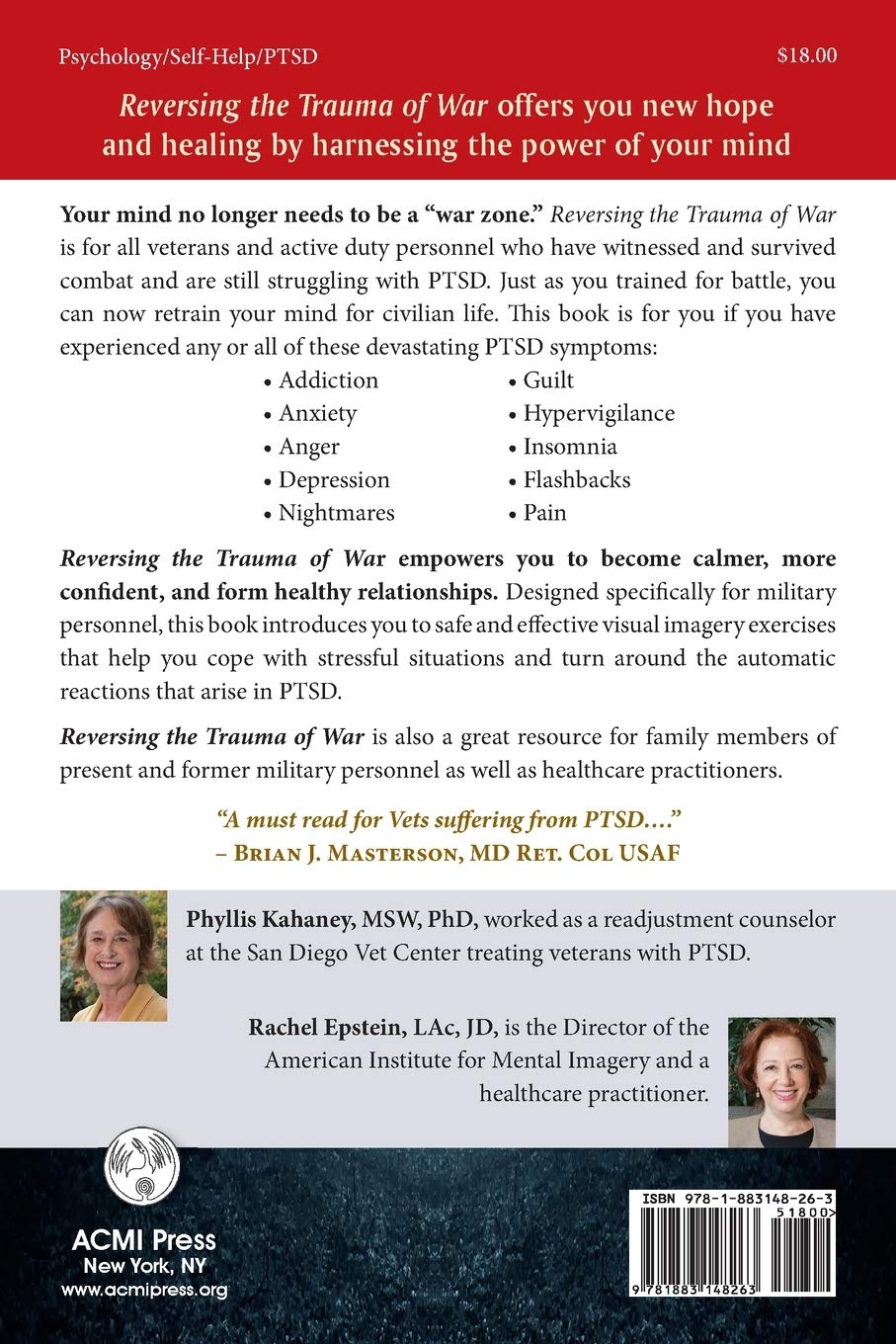Reversing the Trauma of War
A workbook using mental imagery to address and overcome PTSD challenges for veterans, active duty personnel, their families, and individuals grappling with the aftermath of war trauma.

Inside, you’ll find a step by step guide to alleviate feelings of depression, anxiety, isolation, despair, and anger.


About Reversing the Trauma of War
From two leaders in the field of mental imagery and visualization therapy comes a bold new method for treating post traumatic stress disorder.
A self help book for veterans, active duty personnel, and their families, Reversing The Trauma of War offers a roadmap for managing, coping with, and healing, from PTSD.
When practiced for several minutes a day for just 3 weeks, the short visualization practices, called mental imagery, have been proven to alleviate the symptoms of PTSD, stress, hyper vigilance, and clear traumatic memories.
Reversing The Trauma of War teaches you how to alleviate feelings of depression, anxiety, isolation, despair, anger, and help you step into freedom.
Where Can I Buy Reversing the Trauma of War?
The book can be purchased in print and ebook at Amazon, Barnes and Noble, and independent bookstores, in the USA, Canada, the UK and Australia.
“A must read for Vets suffering from PTSD…”
—Brian J. Masterson, MD Ret. Col. USAF
Up to 30% of veterans suffer from combat-related PTSD. Suicide rates for veterans are 100-times greater than the civilian average. 55 in 100 women (55%) and 38 in 100 men (38%) report experiencing sexual trauma while in the military.
Almost all veterans and active duty personnel have experienced some form of trauma, impacting not only themselves, but their families, friends, and children.
Designed specifically for veterans, active duty, and reserve military personnel, Reversing The Trauma of War teaches you to take charge of your own healing through daily breathing and visualization exercises proven to reduce the symptoms of PTSD.
Inside, you’ll find a step by step guide to alleviate feelings of depression, anxiety, isolation, despair, and anger. Each section targets a different issue, ranging from hypervigilance, to insomnia and nightmares, to sexual trauma.
Through this book, you can reduce, and even eliminate, stress responses to scent, noise, and visual triggers; The exercises also target physical pain and trauma—from general chronic pain, to specific pain arising from amputation, wounds, and traumatic brain injuries. Three additional sections also address friends, families, and clinicians who support those suffering from PTSD.
Frequently Asked Questions
What is mental imagery?
Mental imagery is a technique that addresses the emotional, mental, and physical manifestations of PTSD by using images in the mind to gently reshape memories, feelings, and beliefs, and transform behavior.
Who should read Reversing the Trauma of War?
The book was designed specifically for military veterans and active duty personnel who suffer from PTSD symptoms, such as anger, anxiety, depression, and insomnia. The book also includes sections that address friends, families, and clinicians who support those suffering from PTSD.
How does it work?
Reversing the Trauma of War provides a step-by-step guide to using mental imagery exercises to treat specific PTSD symptoms. When practiced for several minutes per day for three weeks, the exercises have proven effective in reducing symptoms such as stress and hypervigilance, clearing traumatic memories, and helping those suffering from PTSD lead more hopeful and productive lives. It’s like taking medicine, but instead of taking a physical medicine you are taking a mind medicine.
Where did mental imagery come from?
As detailed in Dr. Gerald Epstein’s article “The Western Metaphysics of Mental Imagery and Its Clinical Applications”, there is a centuries-long tradition of using mental imagery in the Western spiritual tradition as a method to turn our senses inward and tap into ways to direct our lives and heal. Clinicians have used mental imagery for decades to help patients use their imaginations to access their own “Invisible Reality,” which forms the basis of their spiritual life and well-being. Those images form their own language that when translated or “read” can speak truths about our inner selves, unconditioned by external distortions.
What is the difference between imagery, meditation, and hypnosis?
Imagery is a mental exercise used to access another level of consciousness in order to actively discover and explore otherwise hidden areas of one’s self. Meditation is a means of stilling thoughts, sensations, and feelings with the goal of clearing one’s mind. Hypnosis provides a method for leading someone into a deeply relaxed state where will is surrendered in order for a new set of suggestions to be imprinted to change behavior.
Who developed the imagery exercises detailed in Reversing the Trauma of War?
In addition to imagery exercises composed by the authors, Phyllis Kahaney and Rachel Epstein, Reversing the Trauma of War utilizes many imagery exercises drawn and adapted from their teachers’ published works, private notes, and personal communications authored by Mme. Colette Aboulker-Muscat and Dr. Gerald Epstein.
What evidence is there to show mental imagery is effective to help those suffering from PTSD?
Phyllis Kahaney successfully used metal imagery exercises as a core treatment modality during four years of clinical work with veterans at the Vet Center in San Diego. The book includes vignettes detailing some of those positive outcomes. There are also numerous published studies and papers showing mental imagery exercises have led to improvements for people suffering a variety of conditions and ailments, including PTSD, cancer, asthma, and stress. Relevant research studies include three by Dr. Epstein.
Tell me about the authors who wrote Reversing the Trauma of War?
The book was co-authored by Phyllis Kahaney M.S.W., Ph.D. and Rachel Epstein, L.Ac., J.D. In addition to using mental imagery to help treat her own PTSD, Phyllis, who has a doctorate in rhetoric, spent four year using mental imagery as a core treatment modality in her work as a readjustment counselor at the San Diego Vet Center. Rachel is the director of the American Institute for Mental Imagery (AIMI) in New York City, which was founded by her late husband, Dr. Gerald Epstein, M.D. Rachel is an expert in mental imagery and runs a private, imagery based health practice and conducts classes at AIMI on mental imagery.
Visit ACMI Press for more books on mental imagery
ACMI Press is a specialized publishing company blending ancient wisdom with current research, bringing you resources on self-empowerment, healing, and balance. Whether you’re looking to overcome emotional challenges, enhance your physical well-being, or explore the depths of your subconscious, our publications offer you the most effective techniques and practices to facilitate your personal transformation. Delve into our collection to unlock your limitless potential today.
From two leaders in the field of mental imagery and visualization therapy comes a bold new method for treating PTSD
Phyllis Kahaney
M.S.W., Ph.D.

After successfully overcoming the symptoms of PTSD using mental imagery, Phyllis left her position in academia as an English professor to pursue social work.
Phyllis used mental imagery as a core treatment modality in her work as a readjustment counselor for four years at the San Diego Vet Center. That work helped countless veterans to heal from the symptoms of PTSD.
Aside from working with veterans and active duty personnel, Phyllis works in hospice, using imagery in end-of-life care in San Diego.
Rachel Epstein
L.Ac., J.D.

Rachel is the director of the American Institute for Mental Imagery (AIMI) in New York City. An expert in mental imagery, she conducts classes at AIMI in mental imagery and coaches individuals privately.
She received her training from internationally recognized authorities Mme. Colette Aboulker-Muscat and Dr. Gerald Epstein, M.D., her late husband and founder of AIMI, with whom she collaborate on numerous books, including the Encyclopedia of Mental Imagery and Healing into Immortality.
Praise for Reversing the Trauma of War
Contact
We’d love to hear from you!
Contact Phyllis Kahaney at pkahaney@gmail.com
Contact Rachel Epstein at rachelepsteinjd@gmail.com